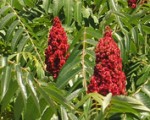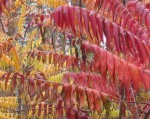 Noted for its outstanding fall coloration in shades of yellow, orange, and red, staghorn sumac is a tall deciduous suckering shrub or small tree native to eastern North America where it is common growing in colonies along woodlands, roadsides and railroad right-aways. The bright green leaves are a pinnately compound and up to 24″ long each bearing elongated leaflets 2-5″ in length. In late spring to early summer tight cone-shaped clusters of greenish-yellow male and female flowers are produced on separate plants. In the fall female plants develop dense clusters of bright red berries that slowly mature to dark red in winter when they provide a source of food for birds. A very adaptable plant, staghorn sumac is attractive massed in large, open areas where its suckering, spreading habit is an asset. It is not suitable for most shrub borders or small gardens but is useful for stabilizing embankments. The common name derives from the fact that the branched stems are covered with velvety hairs and resemble the antlers of male deer “in the velevet”.
Noted for its outstanding fall coloration in shades of yellow, orange, and red, staghorn sumac is a tall deciduous suckering shrub or small tree native to eastern North America where it is common growing in colonies along woodlands, roadsides and railroad right-aways. The bright green leaves are a pinnately compound and up to 24″ long each bearing elongated leaflets 2-5″ in length. In late spring to early summer tight cone-shaped clusters of greenish-yellow male and female flowers are produced on separate plants. In the fall female plants develop dense clusters of bright red berries that slowly mature to dark red in winter when they provide a source of food for birds. A very adaptable plant, staghorn sumac is attractive massed in large, open areas where its suckering, spreading habit is an asset. It is not suitable for most shrub borders or small gardens but is useful for stabilizing embankments. The common name derives from the fact that the branched stems are covered with velvety hairs and resemble the antlers of male deer “in the velevet”.
Type: Deciduous shrub or small tree
 Outstanding Feature: Fall coloration
Outstanding Feature: Fall coloration
Form: Upright, open, spreading
Growth Rate: Olds growth slow; sucker fast
Bloom: Tight cones-shaped clusters of greenish-yellow flowers of male and female flowers are produced in separate plants in late spring to early summer; females produce bright red fruit that matures to dark red in winter
Size: 15-25; H x 20-30′ W
Light: Full sun to part shade; not shade tolerant
Soil:Average to infertile, dry to medium-moist, well-drained; does not tolerate wet soil
Hardiness:Zones 4-8
Care: Cut to the ground to regenerate when necessary.
Pests and Diseases: Generally pest and disease resistant but susceptible to scale, aphids, mites, leaf spots, cankers, blister, rusts, and powdery mildew.
Propagation: Division of rooted suckers; seed
Outstanding Selection: ‘Dissecta’ (deeply divided leaflets)
